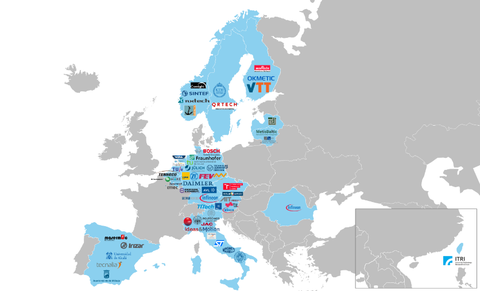Auto Drive
AutoDrive is a research project funded by the European Union and national funds from over 50 organisations from industry and research across Europe (see figure on the right). Core topics are increasing the safety of autonomous driving, the development and validation of safety functions, sensor development and semiconductor technology and the development of fail-safe system architectures with the aim of establishing standards in autonomous driving.
Within the AutoDrive project, the Chair of Automobile Engineering evaluates two safety functions with regard to their influence on traffic accidents. One is "emergency brake assistance" for urban scenarios and the other is a "highway pilot" who performs autonomous lane change manoeuvres.
A microscopic, stochastic traffic simulation with the openPASS framework is set up for
the evaluation. Within this created "test environment", the impact of the investigated safety function on the overall accident situation is investigated.
First, the current real road traffic is modelled without the safety function to be evaluated, the "baseline" (see following figure). The aim is to map and evaluate the current real accident situation based on human error. Each vehicle has a driver behaviour model for this purpose. The driver behaviour model is developed on the basis of human cognition, decision making and decision implementation. Driver modelling is a focus of the project. Together with the Chair of Traffic Psychology at TU Dresden, a simulator study for intersection scenarios will be carried out to parameterize the traffic simulation.
In a second step, the "prognosis", the safety function to be evaluated is integrated into the baseline in different penetration levels. The accident occurrence of the traffic simulation with safety function is also evaluated.
In the third step, the two simulated accident events of baseline and forecast are compared. Now the safety function is evaluated on the basis of the change in accident occurrence. With the help of the evaluation, an initial assessment of the effectiveness of the safety function can be made. In addition, possible weaknesses of the safety function can be identified.


